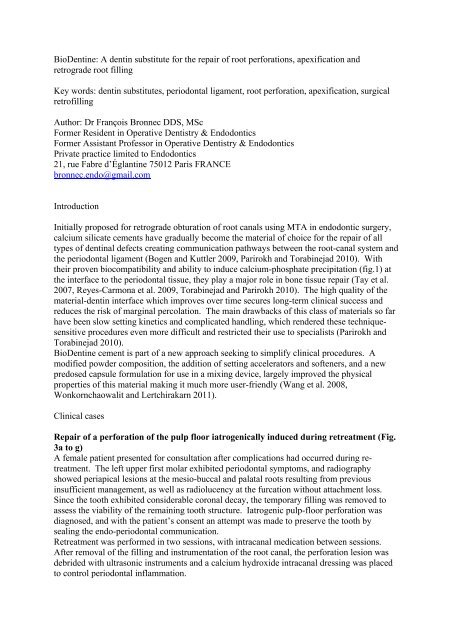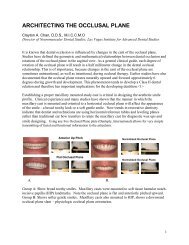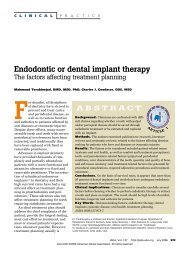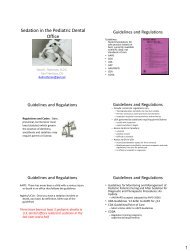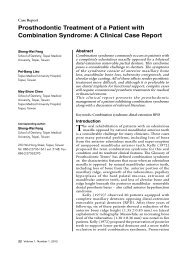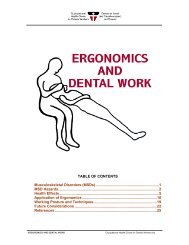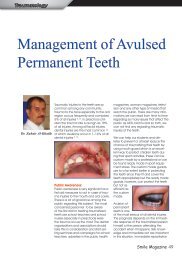BioDentine%20FBronnec%20case%20report%20ENG2
BioDentine%20FBronnec%20case%20report%20ENG2
BioDentine%20FBronnec%20case%20report%20ENG2
You also want an ePaper? Increase the reach of your titles
YUMPU automatically turns print PDFs into web optimized ePapers that Google loves.
BioDentine: A dentin substitute for the repair of root perforations, apexification and<br />
retrograde root filling<br />
Key words: dentin substitutes, periodontal ligament, root perforation, apexification, surgical<br />
retrofilling<br />
Author: Dr François Bronnec DDS, MSc<br />
Former Resident in Operative Dentistry & Endodontics<br />
Former Assistant Professor in Operative Dentistry & Endodontics<br />
Private practice limited to Endodontics<br />
21, rue Fabre d’Églantine 75012 Paris FRANCE<br />
bronnec.endo@gmail.com<br />
Introduction<br />
Initially proposed for retrograde obturation of root canals using MTA in endodontic surgery,<br />
calcium silicate cements have gradually become the material of choice for the repair of all<br />
types of dentinal defects creating communication pathways between the root-canal system and<br />
the periodontal ligament (Bogen and Kuttler 2009, Parirokh and Torabinejad 2010). With<br />
their proven biocompatibility and ability to induce calcium-phosphate precipitation (fig.1) at<br />
the interface to the periodontal tissue, they play a major role in bone tissue repair (Tay et al.<br />
2007, Reyes-Carmona et al. 2009, Torabinejad and Parirokh 2010). The high quality of the<br />
material-dentin interface which improves over time secures long-term clinical success and<br />
reduces the risk of marginal percolation. The main drawbacks of this class of materials so far<br />
have been slow setting kinetics and complicated handling, which rendered these techniquesensitive<br />
procedures even more difficult and restricted their use to specialists (Parirokh and<br />
Torabinejad 2010).<br />
BioDentine cement is part of a new approach seeking to simplify clinical procedures. A<br />
modified powder composition, the addition of setting accelerators and softeners, and a new<br />
predosed capsule formulation for use in a mixing device, largely improved the physical<br />
properties of this material making it much more user-friendly (Wang et al. 2008,<br />
Wonkornchaowalit and Lertchirakarn 2011).<br />
Clinical cases<br />
Repair of a perforation of the pulp floor iatrogenically induced during retreatment (Fig.<br />
3a to g)<br />
A female patient presented for consultation after complications had occurred during retreatment.<br />
The left upper first molar exhibited periodontal symptoms, and radiography<br />
showed periapical lesions at the mesio-buccal and palatal roots resulting from previous<br />
insufficient management, as well as radiolucency at the furcation without attachment loss.<br />
Since the tooth exhibited considerable coronal decay, the temporary filling was removed to<br />
assess the viability of the remaining tooth structure. Iatrogenic pulp-floor perforation was<br />
diagnosed, and with the patient’s consent an attempt was made to preserve the tooth by<br />
sealing the endo-periodontal communication.<br />
Retreatment was performed in two sessions, with intracanal medication between sessions.<br />
After removal of the filling and instrumentation of the root canal, the perforation lesion was<br />
debrided with ultrasonic instruments and a calcium hydroxide intracanal dressing was placed<br />
to control periodontal inflammation.
After 7 days, the tooth was without symptoms and the canals could be dried. The session<br />
started with repair of the perforation to avoid any risk of contamination with endodontic<br />
cement when obturating the canals. The canal orifices were isolated with cotton pellets, and<br />
the dentin defect was filled with 2 layers of BioDentine using an amalgam carrier. The<br />
material was then adapted to the cavity with a cotton pellet without pressure. Once the<br />
material had set any excess material was stripped off with a curette before removing the<br />
cotton pellets and filling the root canal in the same session. At the end of the session, the<br />
hardened material was shaped with a bur to reproduce the pulp floor convexity for the future<br />
restoration of the tooth. The copper band was removed and replaced by a temporary metal<br />
cap luted with glass ionomer cement. Follow-up at three months showed no clinical signs,<br />
and the X-ray confirmed complete healing of the apical and furcation lesions.<br />
Repair of a recent perforation caused during primary endodontic treatment of a<br />
necrotic tooth<br />
A male patient was referred for emergency treatment by his dentist who could not account for<br />
unexpected bleeding when trying to find the mesio-buccal canal of the right lower 2 nd molar.<br />
The tooth was pain-free, probing depth was normal. Radiographic examination revealed a<br />
periapical lesion, and the fusion of the mesial and distal roots of this second molar suggested a<br />
C-shaped canal.<br />
After removal of the temporary filling and pre-endodontic restoration of the crown, the access<br />
cavity was extended for complete view of the pulp floor. Inspection revealed an accidental<br />
perforation of the pulp floor. The tooth being only slightly decayed, it was decided to carry<br />
out a complete preparation of the root canal system before managing the endo-perio<br />
communication. As the site of the perforation was at a safe distance from the canal orifices,<br />
the root canals could be filled before repair of the perforation. Repair of the dentin defect was<br />
then achieved by placing an increment of BioDentine with an amalgam carrier and adapting it<br />
to the wall with a cotton pellet. Once the BioDentine had set hard, excess material was<br />
eliminated with a curette. The access cavity was filled with a 3 mm layer of glass ionomer<br />
cement covered by composite material.<br />
Endodontic surgery after failure of orthograde endodontic retreatment (Fig. 5a to e)<br />
A male patient presented with symptoms that persisted despite previous orthograde<br />
retreatment. The right upper lateral incisor was restored with a post and core buildup, and a<br />
temporary crown has been in place for a few months. Radiographs before retreatment and 3<br />
months later showed a persistent periapical lesion and inflammatory root-end resorption.<br />
Since obturation of the canal system seemed radiographically adequate, surgical retreatment<br />
was opted for.<br />
After raising a full-thickness flap using an incision in the attached gingiva, access to the<br />
defect was obtained with a tungsten-carbide bur in a turbine handpiece with water spray. The<br />
lesion was curetted before resection of the apical 3 mm of the root. After verifying the<br />
absence of any root fractures, the gutta percha and cement filling was removed from the root<br />
canal up to the level of the root post. The canal was instrumented to 6 mm using ultrasonic<br />
tips (EndoSuccess Apical Surgery Kit, Actéon-Satélec, Mérignac, France). After<br />
decontamination and drying of the root cavity, retrograde obturation was completed placing 3<br />
layers of BioDentine with the use of a syringe-mounted carrier system (MAP-system, PDSA,<br />
Vevey, Switzerland). The successive portions of material were deposited in the root end<br />
cavity and adapted to the wall with root canal pluggers. After hardening of the material, a red<br />
(fine) diamond bur was used to surface the root cross-section and eliminate any excess<br />
material. Bleeding into the bone cavity was ensured before repositioning and closure of the<br />
flap with interrupted synthetic sutures (polypropylene 5/0 and 7/0, B Braun, Germany).
The patient was seen after 48 hours for suture removal and to make sure there were no post-op<br />
complications. Upon clinical and radiographic examination 3 months later, the tooth<br />
presented no symptoms and showed radiographic signs of an on-going healing process.<br />
Apexification of an immature tooth (Fig. 6a to b)<br />
A young male patient presented with dental trauma resulting in coronal fracture of the right<br />
upper central incisor. Initial examination revealed that the pulp had been capped in<br />
emergency treatment at the hospital. Radiographically an insufficient root filling was<br />
detected in the left upper central, which also showed incomplete root growth with apically<br />
diverging walls. It was therefore decided that apexification was indicated. Both teeth were to<br />
be treated in the same session, while the restoration of the tooth was to be left to the referring<br />
dentist.<br />
Following removal of the root-canal filling from the left upper central, the endodontic<br />
treatment plan was to fill the apical part of the canal after cleaning and decontamination with<br />
a sodium chlorite solution. Shaping was limited to the coronal third of the canal (Gates drills)<br />
to facilitate direct instrument access to the foramen.<br />
A first increment of BioDentine was inserted into the canal using a curved needle of the<br />
largest diameter fitting into the canal (MAP-system, PDSA, Vevey, Switzerland). The<br />
material was then delicately pushed towards the apex with a root-canal plugger. Several<br />
increments were required to form a plug of adequate thickness (> 4mm). The material was<br />
adapted to the walls by applying indirect ultrasonic vibration through an ultrasonic tip placed<br />
on the plugger touching the material. After verifying that the material was hard-set, the<br />
patient was sent back to his dentist for further treatment and conventional restoration.<br />
Conclusion<br />
Validated experimentally (Bronnec 2009, Laurent et al. 2008, Valyi 2008), the efficacy of<br />
BioDentine as a dentin substitute is yet to be clinically proven for each of its therapeutic<br />
indications. The short and medium-term results of clinical studies conducted in endodontic as<br />
well as restorative fields of application are in the re-evaluation phase, and will be published as<br />
evidence in scientific articles in a few months. The first results observed in a private practice<br />
since the material was launched a year ago, are extremely promising.<br />
Bibliography<br />
BOGEN G & SERGIO KUTTLER S. Mineral Trioxide Aggregate obturation: A Review and Case<br />
Series. J Endod. 2009;35:777–790.<br />
BRONNEC F. Caractérisation des interfaces dentine radiculaire/ciment silicate de calcium en<br />
vue d’une application endodontique. Master thesis (Biomaterial Sciences). Université de Paris<br />
13. 2009.<br />
LAURENT P, CAMPS J, DE MÉO M & ABOUT I. Induction of specific cell responses to a<br />
Ca3SiO5-based posterior restorative material. Dent Mater. 2008;24 :1486-1494.<br />
PARIROKH M & MAHMOUD TORABINEJAD M. Mineral Trioxide Aggregate: A comprehensive<br />
literature review—Part I: Chemical, Physical, and antibacterial properties. J Endod.<br />
2010;36:16–27.<br />
PARIROKH M & MAHMOUD TORABINEJAD M. Mineral Trioxide Aggregate: A comprehensive<br />
literature review—Part III: Clinical applications, drawbacks, and mechanism of action. J
Endod. 2010;36:400–413.<br />
REYES-CARMONA JF, FELIPPE MS, FELIPPE WT. Biomineralization ability and interaction of<br />
mineral trioxide aggregate and white portland cement with dentine in a phosphate containg<br />
fluid. J Endod. 2009;35:731-736.<br />
TAY FR, PASHLEY DH, RUEGGEBERG FA, LOUSHINE RJ & WELLER RN. Calcium phosphate<br />
phase transformation produced by the interaction of the portland cement component of white<br />
mineral trioxide aggregate with a phosphate-containing fluid. J Endod. 2007;33:1347-51.<br />
TORABINEJAD M & MASOUD PARIROKH M. Mineral Trioxide Aggregate: A comprehensive<br />
literature review—Part II: Leakage and biocompatibility investigations. J Endod.<br />
2010;36:190–202.<br />
VALYI E. Ciments alcalins ou acides à usage odontologique : actions sur quelques souches<br />
bactériennes représentatives. Master thesis (Biomaterial Sciences). Université de Lyon 1.<br />
2009.<br />
WANG X, SUN H & CHANG J. Characterization of Ca3SiO5/CaCl2 composite cement for dental<br />
application. Dent Mater. 2008;24:74-82.<br />
WONGKORNCHAOWALIT N & LERTCHIRAKARN V. Setting time and flowability of accelerated<br />
Portland cement mixed with polycarboxylate superplasticizer. J Endod. 2011; in press :1–3.<br />
Captions and figures<br />
Fig. 1: Microscopic view of calcium-phosphate precipitates formed when the material is<br />
exposed to biologic fluids (MEB, x 500).<br />
Fig. 2: Quality of the material-dentin interface showing perfect adaptation and marginal seal<br />
of the filling (MEB, x 1000).<br />
Fig. 3:<br />
3a: Pretreatment radiograph.<br />
3b: Microscopic view of the perforation site.<br />
3c: Calcium hydroxide intracanal medication.<br />
3d & e: Repair of the perforation before obturation of the root canal.<br />
3f: Posttreatment radiograph<br />
3d: Radiograph at 3 months’ follow-up showing complete healing.<br />
Fig. 4<br />
4a: Pretreatment radiograph.<br />
4b: Perforation site viewed through the surgical microscope.<br />
4c & d: Microscopic view of the material in place after setting, and control X-ray film.<br />
4e: Posttreatment radiograph showing completed coronal restoration.<br />
Fig. 5
5a: Initial radiograph before retreatment.<br />
5b: Radiograph at 3 months’ follow-up showing absence of healing.<br />
5c: Microscopic view of the retrograde obturation.<br />
5d: Posttreatment radiograph.<br />
5e: Radiograph at 3 months’ follow-up showing healing in progress.<br />
Fig. 6<br />
6a: Pretreatment radiograph.<br />
6b: Control X-ray before placement of conventional restorations.
Fig. 1<br />
Fig. 2
Fig. 3
Fig. 4
Fig. 5
Fig. 6


